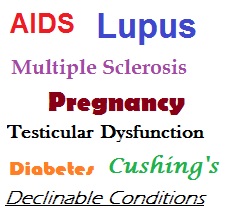
Just because you have a condition that gets you declined from getting health insurance doesn't mean you are any less productive at work.
With the Pre Existing Insurance Plan (PCIP) having enrolled slightly more than 56,000, people nationwide, by the end or February 2012, out of an estimated potential of 375,000, some folks have labeled the PCIP a failure. This is in addition to the subsidy per enrolled member being 2.5 times higher than orginally estimated. Low sales and high expenses will certainly doom any product or service. But the PCIP was not meant to be a success by business ROI standards or a long term government program.
The PCIP, authorized in the PPACA of 2010, was meant to provide relatively immediate reliefe to Americans, who had been denied health insurance, until denials for pre-existings are removed nationwide in 2014. Higher than expected costs to insure people under the PCIP is unfortunate, but essentially a mute point since the program will not get close to the full estimated number of subscribers.
The bigger question is, “Why haven’t more people taken advantage of the PCIP program?” To start off, the insurance is not free, but subsidized. In California, a 45 year old person will have a monthly premium of $335 to $369. In addition, the PCIP was launched amidst the worst economic downtown in the last 80 years.
From my experience, many of the folks I discussed the program with had lost their jobs, ran through COBRA, were still out of work, living on savings and the $300+ monthly premium was still more than they could afford. These were folks that were used to group health insurance plans and desperately wanted health insurance.
We also have to remember that the PCIP was designed so as not to offer competition to existing health insurance companies. The applicant had to be without health insurance for 6 months and be declined by a private carrier. Folks that were transitioning from COBRA to HIPAA or trying to find an alternative to the very expensive guaranteed issue HIPAA plans offered by private carriers were not eligible.
In order to spike the marketing, health insurance agents were offered a $100 one time fee for helping someone file an application. This fee was removed at the end of April. I don’t think it was dropped because of the expense, but the marginal utility to attract additional applicants wasn’t recognized. Although, marketing probably did play a role in not reaching and enrolling more people.
An opinion piece in The Foundry speculated
“The fact that the Administration is pulling back incentives to enroll in its high-risk pool may

Just because she was declined for health insurance for asthma hasn't stopped her from working every day.
signify its acceptance that the pre-existing condition problem is nowhere near as big as it was portrayed during the health care debate. This is yet another reminder that Obamacare isn’t just terrible health policy with disastrous consequences; it’s overreaching, taxpayer-funded programs that our country didn’t need.”
This statement is flawed on several levels. The pool of hisk-risk people with pre-existing conditions is certainly as big as has been estimated. Low enrollment doesn’t necessarily equate to low demand or actual small numbers. The numbers of people denied health insurance because of pre-exisiting conditions is enormous. The PCIP is neither disaterous nor overreaching. Their statement implies that the people who are insured through the PCIP are not worth the tax payer funds.
The people I have helped enroll in PCIP own small businesses and get up and work everyday. It was not their fault that they are cancer survivors or have a chronic illness that is managed. Daily, they face the tasks of their jobs knowing that they are one hospital stay away from bankruptcy. If there was ever a group of individuals that were worthy of a little help with health insurance, it is these men and women that work everyday.
From the CMS report COVERING PEOPLE WITH PRE-EXISTING CONDITIONS, February 23, 2012
Many PCIP enrollees have a variety of health conditions that are serious and require ongoing medical treatment. Data from the Federally-administered PCIP, as of November 30, 2011, show that 78 percent of the total cost of the program goes to provide care for four serious types of medical need:
• Cancer: 27 percent of total costs;
• Diseases of the circulatory system, like coronary artery disease: 18.6 percent;
• Rehabilitative care and aftercare, like post-surgical care and certain forms of radiation and chemotherapy: 18 percent; and
• Degenerative joint diseases, such as osteoarthritis: 14.4 percent.
I suppose there are those that want to disparage folks that have enrolled in the PCIP for there own selfish purposes. From my perspective, having my tax dollars help out these folks until the pre-existing condition clauses are purged in 2014 is money well spent. The PCIP program is not a failure and the people enrolled and benefiting from the health insurance are more productive because of it.

